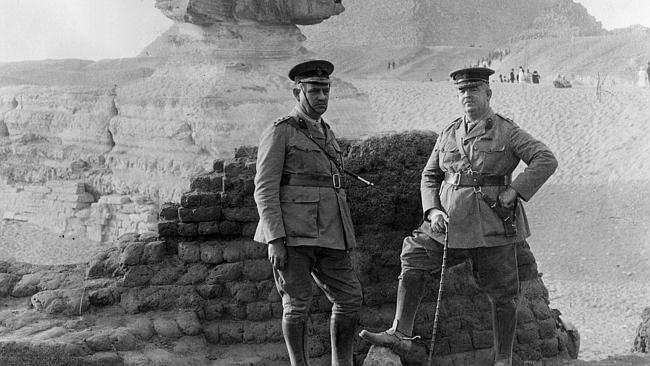Monash’s skills as soldier-engineer changed face of war
ON the eve of WWI, the readers of Scientific American agreed that wireless telegraphy was the most significant invention.

ON the eve of World War I, the readers of Scientific American magazine agreed that wireless telegraphy was the most significant invention of their generation, closely followed by the aeroplane and the X-ray machine.
Other choices in the technological top 10 were less predictable. In sixth place, ahead of incandescent lamps, the internal combustion engine and the submarine, was a relatively new construction material: reinforced concrete.
History proved the magazine’s readers prescient.
When deployed as a defensive weapon, this mundane technical development, barely considered outside the construction business, would have brutal impact on World War I, extending its duration and magnifying casualties.
It would take three years for Allied commanders to wake up to the significance of the enemy’s investment in steel and concrete fortifications or to realise the combination of German technical expertise and an innovative, virtually indestructible material, would transform the nature of modern warfare.
And it took the arrival of Lieutenant General John Monash to inspire a decisive change in Allied strategy that went on to save countless lives and counter Germany’s advantage.
To a generation of military leaders schooled in cavalry warfare, the idea of building permanent fortifications on a front line that could shift by a dozen or so kilometres by tomorrow seemed wasteful and defeatist. Monash changed that.
A civil engineer, Monash knew German civil engineering capability better than most. Two decades earlier he had acquired the rights to a German-owned patent and pioneered the use of reinforced concrete in Australia. He appreciated its strength and versatility, the full potential of which was only just becoming apparent in 1914.
By August 1915, however, as the war entered its second year, Germany’s ability to create an apparently impenetrable line of defence using reinforced concrete had become apparent.
The New York World’s Edward Alexander Powell, who took advantage of the US’s neutrality to report from behind German lines, saw first hand the extent of German innovation. “The Germans are not simply entrenched,” he wrote. “They have protected themselves with masses of concrete and steel armour.”
Throughout the costly battles of 1916 and 1917, Allied commanders failed to grasp the technological gap separating the two forces or develop military strategies to overcome it.
Entire villages were reduced to rubble and landscapes stripped of flora and fauna, but the German garrisons took cover, secure in their concrete dugouts out of sight of the Allies.
A British soldier, George Wear, described the scene that met soldiers at the front: “There were no trees, no houses, no countryside, no shelter, no sun. Wet grey skies hung over the blasted land, and in the mind a gloomy depression spread. Trenches had disappeared. ‘Pill boxes’ and shell holes took their place.” The infantrymen advanced straight into a trap. The German trenches appeared empty, albeit blocked at every turn by a maze of barbed wire forcing them into an area predetermined by the enemy, surrounded with camouflaged gun emplacements.
This was the landscape that greeted Monash when he took command of the Australian 3rd Division in July 1916. The importance of Monash’s training as an engineer in bringing new thought and organisational vigour to operations on the Western Front is well appreciated.
But far less remembered is his pioneering use of reinforced concrete. In 1897, his company, Monash and Anderson, became the Victorian agents for “Das System Monier”, a method of concrete construction originally developed by a French gardener, Joseph Monier, but marketed by a German, Gustav Adolf Wayss.
They were responsible for Australia’s first reinforced concrete bridges, building the Fyansford Bridge on the Barwon River and the Anderson Street Bridge across the Yarra.
In 1905 he formed the South Australian Reinforced Concrete Company in Adelaide, using Brighton cement to construct a 32m swimming pool at St Peters College, the first of its kind in Australia. He installed pipes from the pool to the cricket oval, allowing surplus water to irrigate the turf. He also pioneered the construction of giant concrete grain silos, building the first at Rupanyup in Victoria.
Armed with a practical appreciation of the strength and versatility of the material from which the German defences were constructed, he developed a strategy to beat it, putting it into effect at the Battle of Messines in June 1917, the first in which Australian and New Zealand troops had fought side by side since Gallipoli.
It was preceded by a massive explosion of 19 underground mines in an episode celebrated in the movie Beneath Hill 60.
Monash’s chief innovation, however, was to follow the first wave of troops with a second group tasked with “mopping up” — the killing or disarming of enemy troops found in hiding, laying siege to dugouts until their occupants surrendered, encouraged, in Monash’s own words, “by a liberal use of phosphorous bombs or Mills grenades”.
The strategy was repeated at the Third Battle of Ypres between August and November, and in the Battle of St Quentin, and later in the battles of the Hindenburg Line, where the sophistication and scale of the interlocking series of concrete defences gave Monash pause to think about the nature of modern warfare.
The fortifications, said Monash, built on a stupendous scale “have, of course, no offensive value whatever”, yet they had radically changed the balance of the war, pitching ill-equipped, poorly led soldiers into an unequal contest with the unforgiving strength of concrete.



